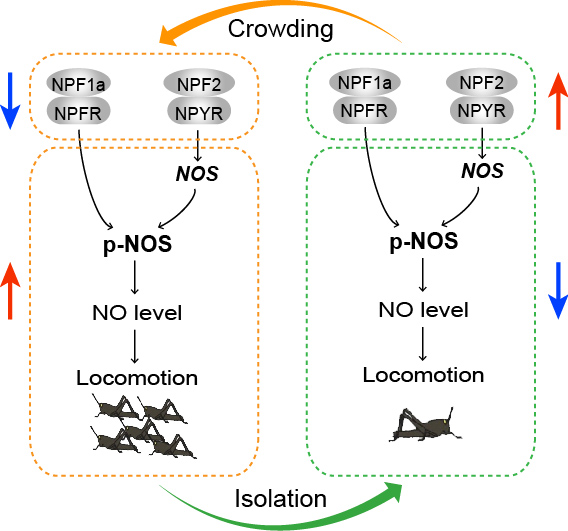Swarming widely occurs in the animal kingdom. Colonial individuals usually change their behaviors to adapt environmental variation, thus displaying distinguish behavioral plasticity. A series of neuromodulators have been implicated in behavioral regulation. Nevertheless, the molecular mechanisms by which these factors shape behavioral plasticity in swarming animals is poorly understood.
Locusts can appear as both solitarious and the gregarious states. Forced crowding of solitarious locusts leads to gregarious state in which they are more active and sociable, which in turn promotes swarming. Whereas isolating individual locusts has the opposite effect, resulting in the solitary state insects with less activity. Thus, the locust phase transition has provided an excel model to study behavioral plasticity underlying swarming.
Recently, a novel study reported by Kang’s Group from the Institute of Zoology, Chinese Academy of Sciences, reveals an “double-brake” like neural and molecular mechanism underlying locust swarming behavior. This study reveals that two related neuropeptides, NPF1a and NPF2, play key roles in the locomotor plasticity of swarming migratory locust. Both of the two NPFs negatively regulate phase-related locomotor through controlling nitric oxide (NO) synthesis. Mechanistically, NPF1a and NPF2 modify nitric oxide synthase (NOS) activity by separately suppressing its phosphorylation and by lowering its transcript level through their respective membrane receptors.
This finding not only uncovers a hierarchical neurochemical mechanism underlying behavioral plasticity in the swarming locust, but also demonstrates the non-redundant roles of two related peptides in regulating animal behaviors upon environmental variation.
This study entitled ”The neuropeptide F/nitric oxide pathway is essential for shaping locomotor plasticity underlying locust phase transition” was published online in the eLife journal in March 27th. Li Hou is the first author, Le Kang and Xianhui Wang are the corresponding authors of this paper. It was supported by Strategic Priority Research Program of the Chinese Academy of Sciences and National Natural Science Foundation of China.
https://elifesciences.org/content/6/e22526

A model for locomotor plasticity modulation by NPF/NO pathway during locust phase transition
Contact:
Wang Xianhui
Institute of Zoology, Chinese Academy of Sciences (http://english.ioz.cas.cn/)
Chaoyang District, Beijing 100101, P.R.China
Email: wangxh@ioz.ac.cn

